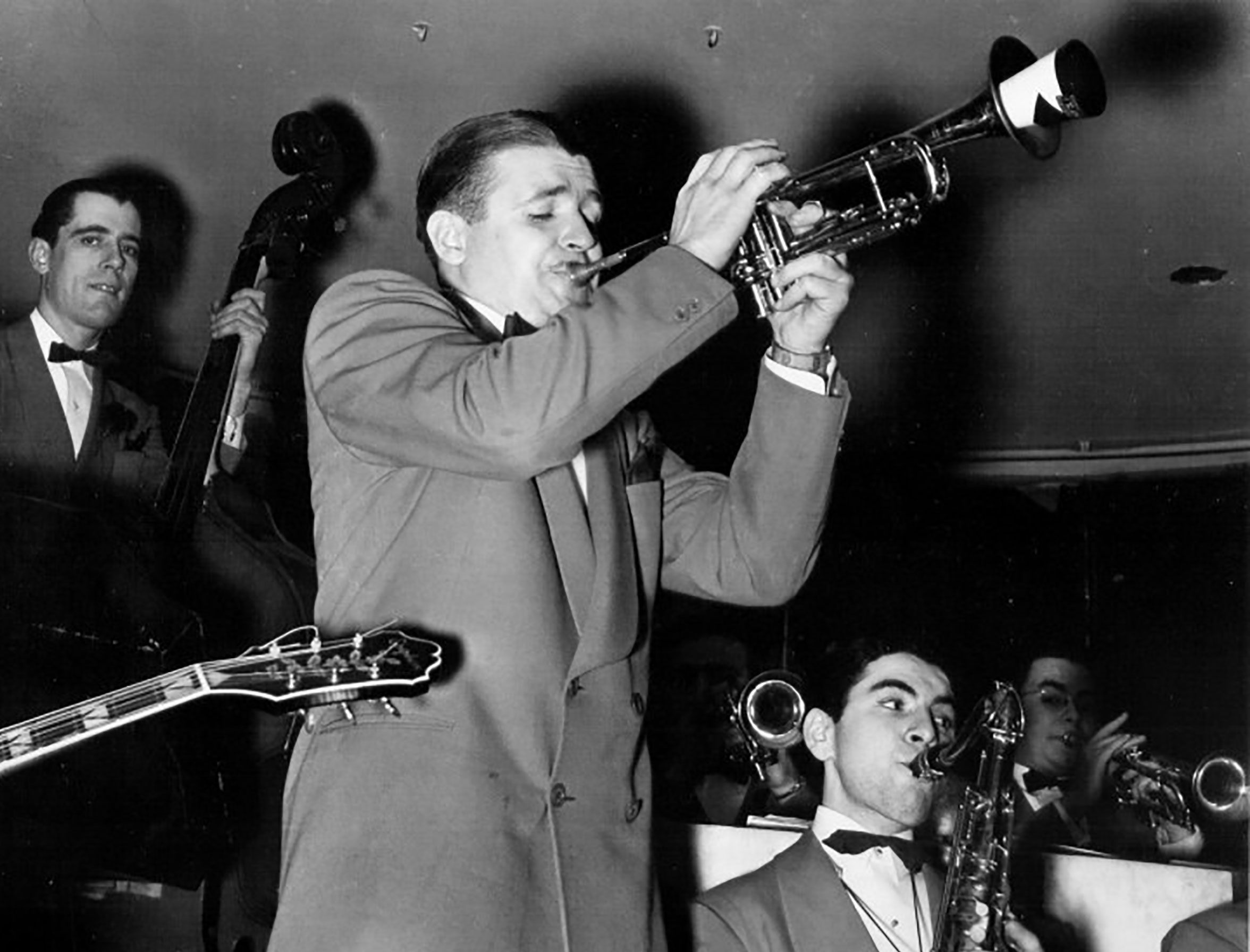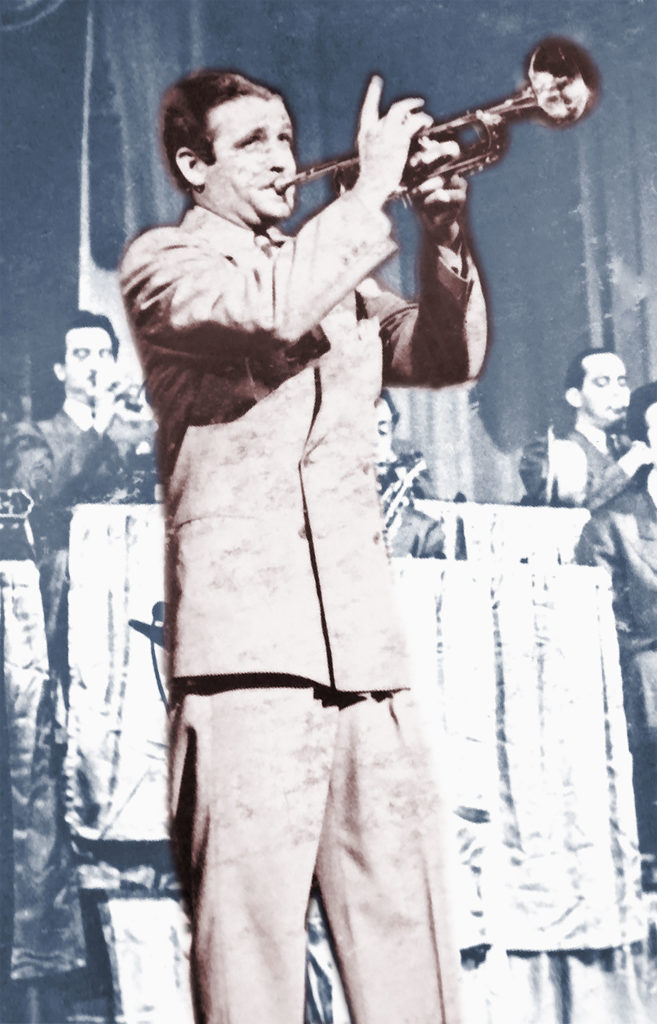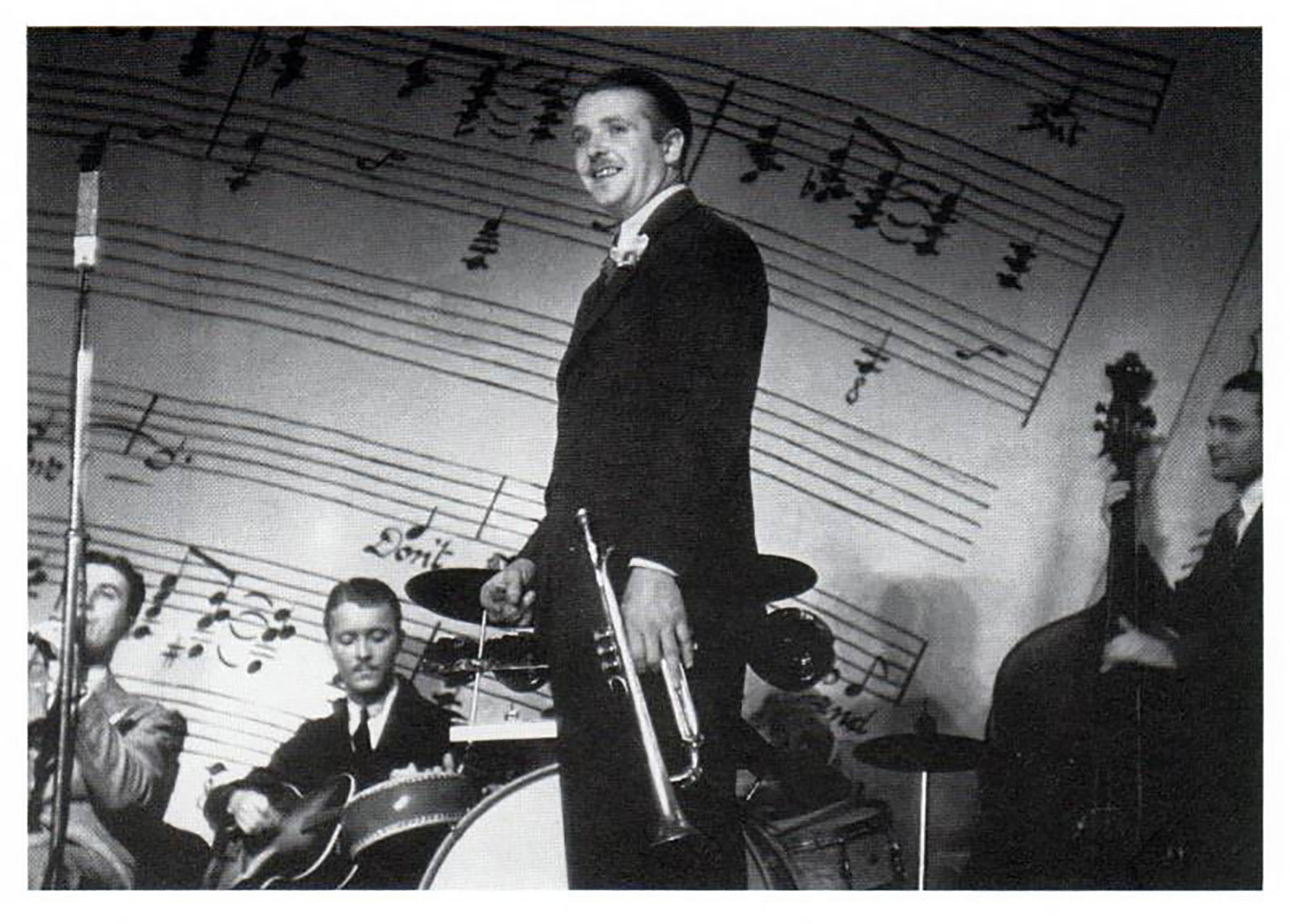
Jazz trumpet player Bunny Berigan in Spring of 1938 with bassist Hank Wayland, tenor saxophonist Georgie Auld and trumpeter Steve Lipkins.
“It was a tight little band, just a family of bad little boys,
with Bunny the worst of all . . . Oh it was a mad ball.”
— Trombonist Ray Conniff recalling the Berigan Orchestra
Bunny Berigan (1908-1942) was best known for his hit recording of “I Can’t Get Started” on which he sang and played trumpet. He was one of the first to play the horn equally well from the top to bottom of its range. He successfully fused in his personal style, the extroverted power of Louis Armstrong with the nuanced tonal palette of Bix Beiderbecke.
Berigan was a charming, popular and charismatic performer. By all accounts the experience of hearing his horn in live performance was electrifying. Some listeners who heard Berigan in person have said that his trumpet sound was “life-changing.” For others, there were no adequate words to describe his playing; you had to be there to experience the magic.
A tall handsome dark-haired Irishman, Berigan was deeply adored by his fans and admired by fellow musicians. The inspiring sound of his horn soared above the finest bands of the Swing era, gracing some of the biggest hits of Glenn Miller, Billie Holiday, Benny Goodman and Tommy Dorsey. More than 600 surviving recordings are evidence of his remarkable ability to make a tune his own and his mastery of his instrument. Sadly, despite all his talent and success Bunny Berigan died from alcohol abuse at age 33.
A Musician’s Musician
Starting around 1930, there was an increasing demand for Berigan’s tremendous talent — from the Dorsey brothers, the Boswell Sisters, Paul Whiteman, Artie Shaw, Red Norvo, Bing Crosby, CBS and NBC radio networks as well as the Columbia, Vocalion, Decca, Victor and Brunswick record companies.
A fine rundown of “The Prisoner’s Song” was on the flip side of his biggest hit (the 1937 extended-play version of “I Can’t Get Started”). Despite Chick Bullock’s dated singing technique, “Swing Mr. Charlie” is one of the great dance band charts of the Swing era.
Swing, Mr. Charlie
The Prisoner’s Song
It was a long hard road to fame and success for Bunny. Much of his early career was spent grinding out distracted dance music in bland hotel orchestras or steady but uninspiring residencies with less than stellar ensembles. But in 1933 Berigan began making records under his own name.
He wrote several original tunes, including the jaunty “Chicken and Waffles” recorded in 1935 by Bunny Berigan and his Blue Boys. In 1936 he won the Metronome Magazine poll among trumpeters. The subsequent 1937 recording date, A Jam Session at Victor, teamed Bunny with prestigious peers: trombonist, Tommy Dorsey; drummer George Wettling; guitarist Dick McDonough and Fats Waller. They recorded “The Blues” and Waller’s “Honeysuckle Rose.”
Intro – Chicken and Waffles, You Took Advantage of Me, The Blues, Honeysuckle Rose
“I Can’t Get Started”
Berigan should be celebrated for his superb horn playing. But it’s his trumpet and vocal rendition of “I Can’t Get Started” for which he’s best remembered. His magnificent 1937 extended-length version caught the mood of the day. It was his biggest hit and made him a household name. His plaintive rendition has charmed listeners ever since and now resides in the Grammy Hall of Fame.
It was from the 1936 Ziegfeld Follies, with music by Vernon Duke and lyrics by Ira Gershwin. “Bunny loved it from the first moment he heard it,” reported band piano player Joe Bushkin and they added it to nightly performances at the Famous Door on 52nd Street in New York City. “I Can’t Get Started” quickly became his trumpet feature, most requested number and theme song.
Jazz researcher, musician and author Dick Sudhalter (1938-2008) wrote a deeply researched 850-page tome called Lost Chords: White Musicians and Their Contribution to Jazz. He offers thoughtful analysis of Berigan and the song. Berigan first waxed it for the Vocalion label in April 1936, a performance Sudhalter characterizes as “unselfconscious, relaxed, almost carefree,” declaring it a tour de force “moving easily throughout the entire range of his horn.”
Berigan recorded the longer 12-inch 78-rpm version in August 1937. Arranged by piano player Joe Lipman, Bunny dramatically sets the stage with an opening four-episode cadenza. Sudhalter finds the expanded rendition a grand gesture that “exudes an aura of gravitas.”
I Can’t Get Started – 1936
I Can’t Get Started – 1937
- (Page 1 of 3)
- Next page →




For more about Berigan see:
Mister Trumpet
https://bunnyberiganmrtrumpet.com/
Scott Yanow on Berigan
https://syncopatedtimes.com/bunny-berigan-profiles-in-jazz/
Richard Sudhalter’s Lost Chords review
https://www.baltimoresun.com/news/bs-xpm-1999-02-28-9902280305-story.html
Richard Sudhalter obituary NY Times
https://www.nytimes.com/2008/09/20/arts/music/20sudhalter.html
Jazz Rhythm Berigan page
http://www.jazzhotbigstep.com/5018.html
Beiderbecke on Jazz Rhythm
http://www.jazzhotbigstep.com/33301.html
Beiderbecke at Red Hot Jazz Archive
http://www.redhotjazz.com/bix.html
Albert Nicholas told me that Bunny was the most respected trumpeter among the colored musicians.
They praised him highly. He was a king. What a waste of talent this alcohol was.